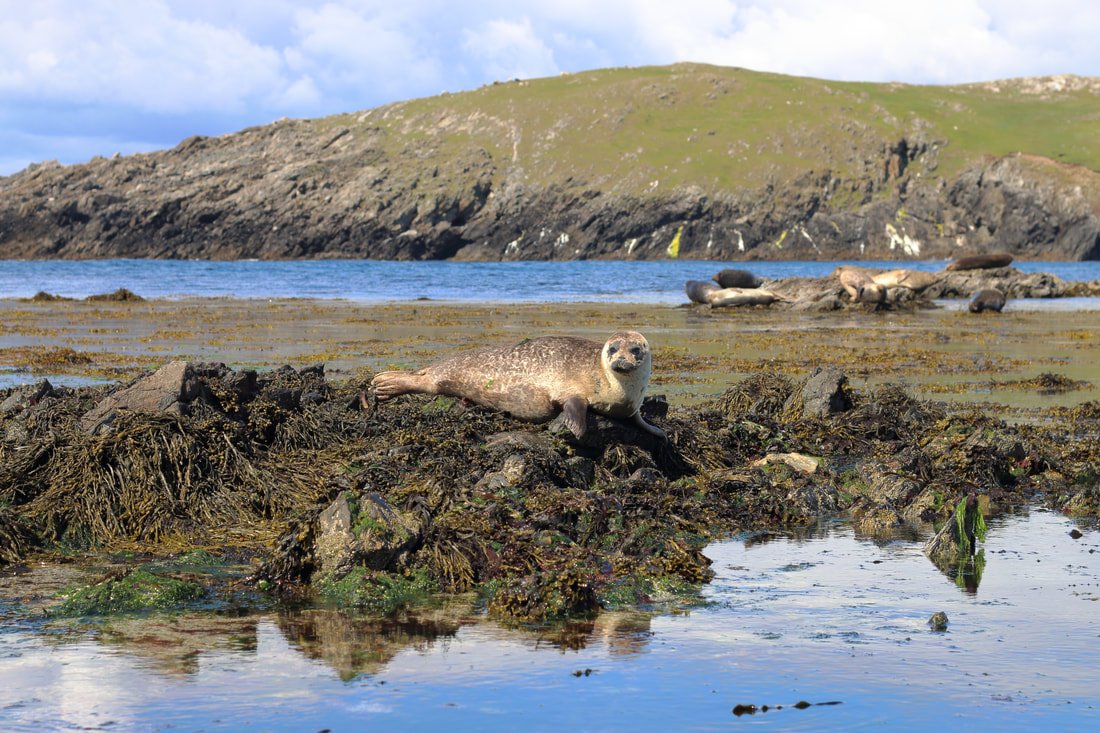Where in Shetland do you find …
Hermaness puffin, Shetland
Puffins?
Puffins are one of the Northern Isles’ best-loved summer visitors who arrive back from winter at sea to nest between April and mid-August. Sumburgh Head is the most accessible place to see them without having a lengthy walk. The nature reserves of Hermaness and Noss are also excellent places to look out for these charismatic little seabirds.
For those travelling with children – or the big kids amongst us – hop on UnstFest’s Tammie Norie Hunt. Tammie Norie is the local name for a puffin, and UnstFest has organised a puffin trail throughout the island where visitors can follow clues to find 12 puffin statues scattered across the island. Visitors can access a map at Belmont, close to the ferry.
UnstFest's TamieNorie Hunt, Unst
Edmondston's Chickweed, Unst
Edmondston's Chickweed?
Endemic to a single hillside in Unst, Edmondston’s Chickweed, which flowers throughout the summer on a barren hillside at the Keen of Hamar, is a botanical rarity not found anywhere else in the world. Alongside Edmondston’s Chickweed (Cerastium nigrescens), you may also spot Northern Rock Cress (Arabis petraea), Hoary Whitlow Grass (Draba incana) and Norwegian Sandwort (Arenaria norvegica).
Steatite - soapstone - bowl carvings from prehistoric times, Fetlar
Visit Shetland Museum & Archives and discover some of the islands’ incredible Pictish carvings. Look for The Monk Stone, a Pictish altar with carvings of Christian missionaries and the Scatness Bear, a carved stone bearing the image of a bear, found during excavations of a Pictish wheelhouse at Old Scatness.
Perhaps you’d like to get out in the field and see some prehistoric carvings. Look for steatite (soapstone) workings in the rocks at Catpund Quarry, Fethaland and Houbie in Fetlar. These are areas where Viking and Norse settlers hewed out circular bowls from the rock faces, carefully prising them out. Chisel marks are still evident at these sites today!
Otter family. Photo Brydon Thomason @ShetlandNature
Otters?
Shetland is one of the best places to view the Eurasian otter, and although elusive, they are often seen unexpectedly. Look out for them around Lerwick Harbour, Hay’s Dock – where Shetland Museum sits – and around the coastline where Fjara Cafe serves fantastic food and drink with uninterrupted sea views. The shoreline of Yell is an excellent place to sight otters – just be sure to remain quiet and downwind of them, so they don’t sense your presence. Remember to scan the shoreline as you wait for an inter-island ferry, as otters, known locally as dratsis, often favour areas protected by rock armour. Shetland has the highest density of otters in Europe, and they’re generally seen feeding just offshore at mid to low tide.
Seals in Burra, Shetland
Seals?
Seals, both common and grey, are abundant around Shetland and are often seen in the water accompanying visitors as they walk the coast – or hanging around Lerwick Harbour. Take a drive to the South Mainland, where you can often see dozens of seals hauled up on the beach at Rerwick. Don’t go down to the beach as you may disturb them – these seals are best viewed from the roadside passing place above.
Seals at Rerwick Beach, South Mainland
Red-necked phalaropes?
Fetlar’s Mires of Funzie are the place to see the incredible red-necked phalarope. In an unusual role reversal, males raise chicks while females seek another partner. Incredibly, they winter near the Galapagos Islands, making an annual journey back to Fetlar each year. These stunning little waders, known locally as ‘peerie deuks’, favour swimming on small lochs or pools and breed amongst vegetated cover.
Storm petrels?
Britain’s smallest seabird, the European storm petrel, is found on the island of Mousa, where The Mousa Boat runs evening tours into the island so that guests can enjoy the return of these enigmatic little seabirds who return, under cover of darkness, to avoid predation. Witnessing the return of these incredible seabirds to their nesting sites within the walls of a 2,000-year-old broch is an astonishing collision of the natural world with the island’s archaeological past.
Gaada Stack, Foula
Sea Stacks?
Shetland’s coastline is punctuated with stacks, geos, arches, inlets and skerries. Perhaps the most dramatic sea stacks are found in the northwest corner of Shetland, around Northmavine. The Drongs, visible on the road between Hillswick and Eshaness, are the most impressive. For anyone venturing to Foula, Shetland’s most westerly island, Gaada Stack is unmissable – particularly set against the setting sun.
Cowrie shells, known as grottie buckies
Cowrie Shells?
This is a closely guarded secret that islanders keep under their hats! Cowrie shells, known locally as grottie buckies, are believed to bring luck to the finder, and people don’t often share their favourite grottie buckie beaches. But, any exposed, shell-sand beach may throw up a treasure …
Lund Standing Stone, Unst
Standing Stones?
Shetland lacks the stone circles of Orkney, but no shortage of impressive standing stones rise from the ground as solitary monoliths in the landscape. Shetland’s largest standing stone is found in the island Unst, where the Lund standing stone commands the gentle landscape.
Whatever you discover on your travels, make sure you have a camera in hand to capture those special moments!
Until next time,
Ways you can support my work…













